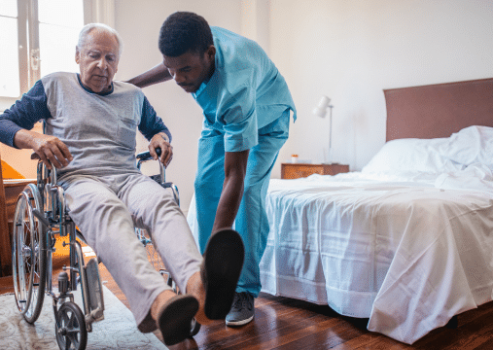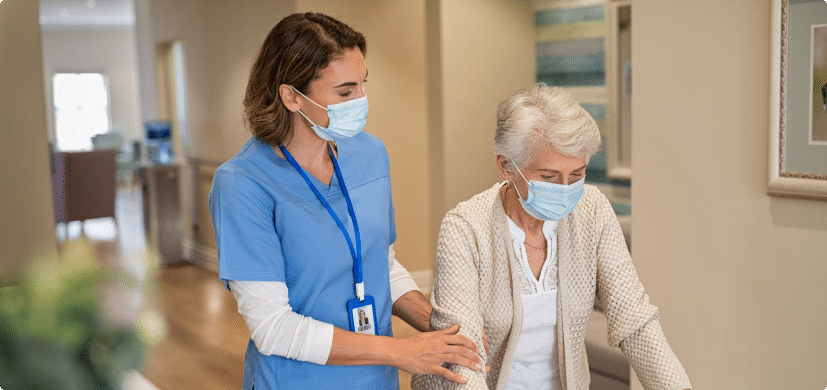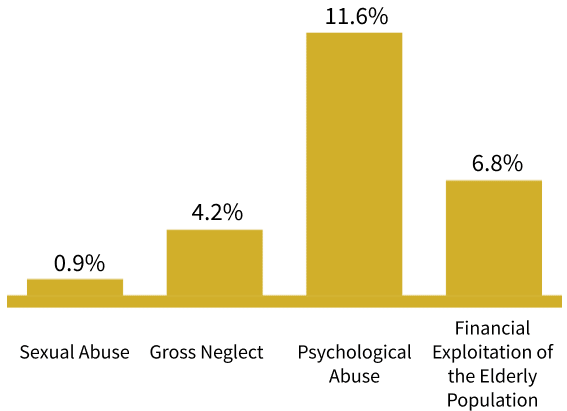Common Injuries in Nursing Homes
Injuries in nursing homes are widespread. Each year, tens of thousands of nursing home residents face serious injuries in the same facilities that promise to care for them. These injuries have various causes, such as abuse or neglect. They can range from minor to severe, and in the worst cases, result in death.

It’s important to familiarize yourself with the most common types of nursing home injuries, signs that might indicate abuse or neglect, and legal rights you can pursue if you or someone you know is injured while a resident of a nursing home.
Common Nursing Home Injuries
Various types of nursing home injuries result from accidents that occur from abuse during daily activities or neglect by staff members and caretakers. Some of the more common types of injuries include:
1. Bedsores
Bedsores happen when a lack of movement leads to excess pressure on the skin. They can be very painful, and in severe cases, they can become infected. Nursing home residents might spend a lot of time in bed with little to no movement, so regular repositioning is essential.
Bedsores can also be caused by poor health, sedation, and surgical recovery. Allowing them to go untreated over time can cause the sores to become extremely painful ulcers, resulting in cancer or sepsis and even leading to death.
2. Broken Bones and Fractures
When a patient is admitted into a nursing home, they may be at high risk for slips and falls due to age-related changes such as poor balance or vision loss. In addition, patients may lose their footing on wet surfaces in poorly maintained hallways or bathrooms that have not been adequately cleaned. These injuries can be the result of a lack of supervision by nursing home staff.
Broken bones and fractures caused by falls can be very dangerous since older patients’ bodies may not heal as well as they once did. Additionally, osteoporosis and arthritis can limit mobility even after a fracture heals.
3. Dehydration and Malnutrition
A lack of proper food and fluids causes dehydration and malnutrition. These ailments can lead to unintentional weight loss and other health issues such as infections, confusion, and a weak immune system.
Inadequate staffing, high nurse turnover, lack of individualized care, refusing or forgetting to cater to a senior’s basic needs, and other issues within nursing homes might cause dehydration and malnutrition. Swallowing disorders, Parkinson’s disease, stroke, and other neurological diseases also play a part in this type of injury. Unfortunately, nearly 40% of nursing home residents suffer from malnutrition and/or dehydration, according to a recent study.
4. Asphyxiation
Asphyxiation occurs when patients do not receive enough airflow to breathe properly. It can result from an obstructed airway, which is quite common in nursing home patients who use feeding tubes or have respiratory conditions like chronic obstructive pulmonary disease (COPD). Asphyxiation requires immediate medical attention and care as it can result in brain injury or death.
5. Infections
Infections can spread easily within nursing homes, because of the nature of their patient population. Many nursing home patients suffer from weakened immune systems due to age-related health conditions like dementia or Alzheimer’s, making them more vulnerable to urinary tract infections, skin infections (i.e. scabies), respiratory infections, Influenza, and soft tissue infections. An estimated 2 million infections occur in U.S. nursing homes annually.
6. Head Injuries
Head injuries are another common nursing home injury that can be caused by physical abuse or neglect, especially due to slips and falls. They are dangerous because they often result in concussions, severe brain damage, and even death if the patient doesn’t receive immediate medical attention.
7. Bruises and Skin Tears
Bruising and skin tears are prevalent types of nursing home injuries. They can be caused by physical abuse or neglect. Infrequent changing of a patient’s clothes or bedsheets, for example, can lead to bedsores if left untreated for too long. Skin tears also occur when a patient’s skin is left exposed to moisture for too long leading to infection if not properly treated. In some cases, however, these injuries are just the result of poor hygiene, balance, or vision.
8. Cuts and Lacerations
Cuts and lacerations are also common injuries in nursing homes. Minor cuts can occur no matter the adequacy of a nursing home staff. Still, these types of wounds need to be cleaned and treated by a doctor right away to reduce the risk of infection, which is especially dangerous for older adults with weak immune systems.
9. Welts
Welts are more severe physical injuries than cuts or bruises. Therefore, they require close monitoring by a doctor for infection, and some welts might require stitches if they do not heal properly on their own.
10. Spinal Injuries
The elderly can easily suffer from spinal injuries, especially after a fall. This type of injury can lead to diseases such as pneumonia and paralysis, and even death. It can also cause other complications such as respiratory issues, partial or total loss of feeling, and paralysis of arms and other body parts. In nursing homes, a spinal injury can occur if:
- A staff member drops a resident during transportation
- An abusive or careless staff member pushes a resident to the floor
- A resident is deprived of equipment needed to help them stand and move
- A resident falls or trips

Common Causes of Nursing Home Injuries
The most common causes of injuries are inadequate protection measures in the nursing home. Other causes include:
Environmental hazards in the patient’s surroundings (tripping hazards, lack of adequate supervision)
Lack of infection control procedures in the nursing home facility
Another major cause of injuries is neglect or abuse, which could be intentional or not. However, elderly adults might refuse care and neglect their own wellbeing if they have dementia or Alzheimer’s disease.
Nursing home injuries are especially serious. In older patients, injuries can take much longer to heal. In addition, bedsores can lead to more severe conditions, such as bone fractures and infections, and in the worst scenarios, lead to death.
How often does abuse and neglect occur in nursing homes?
Globally, an estimated 5,000,000 people are affected by elderly abuse every year, according to the NCOA. The rate of injuries resulting from abuse and neglect in nursing homes has increased over the years Additionally, during the COVID-19 pandemic, the numbers have grown even more significantly.
According to WHO research, 1 in 6 people 60 years and older experienced abuse in a community setting in 2020. In addition, 64.2% of staff members have admitted to 5,000,000 people are affected in the past year. Abuse cases were comprised of the following:

As many countries are experiencing a rapidly aging population, elderly abuse that leads to injuries is anticipated to increase. Currently, the elderly abuse prevalence in community settings is reported to be 15.7%.
What are signs of abuse or neglect in nursing homes besides physical injuries?
Emotional abuse can be a challenging form of abuse to identify, especially when some seniors already have dementia and Alzheimer’s disease, which may make them act out in ways that seem aggressive.
Signs that a nursing home resident is being physically or emotionally abused include:
- Aggression, fearfulness, and anxiety
- Reluctance to speak when a specific staff member is in the room
- Becoming withdrawn or losing interest in their surroundings
- Sudden changes in behavior
How can you prevent nursing home injuries?
Typically, a nursing home or residential care facility is responsible for any harm done to its residents. This includes injuries caused by negligence if you can prove that a senior was hurt due to a staff member’s error in judgment.
Nursing homes are legally liable when a lack of attention or action results in you or your loved one being injured. Other parties responsible for nursing home injuries include:
- Staff members responsible for medical assistance, nutritional assistance, hygiene, and general care can be held accountable alongside their employer if they fail to fulfill their duties or intentionally harm the seniors.
- Maintenance staff responsible for keeping the facility free of potential hazards can be liable if they fail to fulfill their duty.
- Other residents can also be responsible if they commit reckless or dangerous actions that cause harm to you or your loved one.
What action can I take?
If you become aware of a senior who has been neglected, abused, or exploited in a nursing home, there are three ways that you can take action. The first thing to do is ask for a thorough investigation from an adult protective service agency. The second thing you can do is to contact the police and press charges. Finally, you can take civil action by pursuing an abuse or neglect lawsuit.
You might pursue a civil action against:
- The staff member or individual responsible for the abuse or neglect
- The nursing home operator or owner for hiring untrained staff, failing to ensure faculty safety, or failing to meet reasonable industry standards
- Staff or service suppliers who contributed to the neglect or abuse

Seek Legal Help
You should immediately seek out the legal options available to you if you or your loved one has been injured due to abuse or neglect in a nursing home.
Do not be afraid to share your story or ask questions. It is of utmost importance that we raise more awareness of elderly abuse as the older population grows and their needs continue to be unmet.
- Last Modified August 9, 2023
- Editorial Guidelines
Dr. Patricia Shelton, MD

Education:
- University of Washington, Doctor of Medicine – MD. June 2008
- University of Washington, Bachelor of Science – BS, Jun 2003
Background:
Neuroscience and Medicine
Career:
- Dr. Shelton primarily writes content for health-related websites, but has also written test prep materials, white papers, published research articles, court documents, and more.
- Dr. Shelton teaches anatomy and physiology at the college level for the National Institutes of Health.
